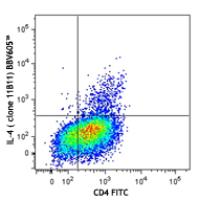-
Sign In
-

-
 Sony Biotechnology
Sony Biotechnology
-

-
 Sony Biotechnology
Sony Biotechnology
Brilliant Violet 605® anti-mouse IL-4
Antibodies Single
Sony
11B11
Flow Cytometry
Rat IgG1, κ
Mouse
Partially purified native mouse IL-4
3120630
$301.00
Description
IL-4 is a pleiotropic cytokine produced by activated T cells, mast cells, and basophils. IL-4 is a potent lymphoid cell growth factor which stimulates the growth and activation of certain B cells and T cells. IL-4 is important for regulation of T helper subset development.
Formulation
Phosphate-buffered solution, pH 7.2, containing 0.09% sodium azide and BSA (origin USA).Recommended Usage
Each lot of this antibody is quality control tested by intracellular immunofluorescent staining with flow cytometric analysis. For flow cytometric staining, the suggested use of this reagent is ≤5 microL per million cells or 5 microL per 100 microL of whole blood. It is recommended that the reagent be titrated for optimal performance for each application.
Brilliant Violet 605™ excites at 405 nm and emits at 603 nm. The bandpass filter 610/20 nm is recommended for detection, although filter optimization may be required depending on other fluorophores used. Be sure to verify that your cytometer configuration and software setup are appropriate for detecting this channel. Refer to your instrument manual or manufacturer for support. Brilliant Violet 605™ is a trademark of Sirigen Group Ltd.
This product is subject to proprietary rights of Sirigen Inc. and is made and sold under license from Sirigen Inc. The purchase of this product conveys to the buyer a non-transferable right to use the purchased product for research purposes only. This product may not be resold or incorporated in any manner into another product for resale. Any use for therapeutics or diagnostics is strictly prohibited. This product is covered by U.S. Patent(s), pending patent applications and foreign equivalents.
References
1. Shirai A, et al. 1994. Cytokine 6:329. (ELISA, Neut)
2. Abrams J. 1995. Curr. Prot. Immunol. John Wiley and Sons New York. Unit 6.20. (ELISA, Neut)
3. Assenmacher M, et al. 1994. Eur. J. Immunol. 24:1097.
4. Openshaw P, et al. 1995. J. Exp. Med. 182:1357. (ICC)
5. Klinman D, et al. 1994. Curr. Prot. Immunol. John Wiley and Sons New York. Unit 6.19. (ELISA Capture)
6. Litton M, et al. 1994. J. Immunol. Methods 175:47. (IHC)
7. Andersson U, et al. 1999. Detection and quantification of gene expression. New York:Springer-Verlag. (IHC)
8. Fan WY, et al. 2001. Exp. Biol. Med. 226:1045. (IHC)
9. Hara M, et al. 2001. J. Immunol. 166:3789. (Neut)
10. Dzhagalov I, et al. 2007. J. Immunol. 178:2113. (ELISA)
11. Lawson BR, et al. 2007. J. Immunol. 178:5366.
12. Wang W, et al. 2007. J. Immunol. 178:4885. (Neut)
13. Xu G, et al. 2007. J. Immunol. 179:5358. (ELISA) PubMed
14. Ohnmacht C, et al. 2008. Blood 113:2816. PubMed
15. Charles N, et al. 2010. Nat. Med. 16:701. (FC) PubMed
16. Zavorotinskaya T, et al. 2003. Mol. Ther. 7:155. (IP)


